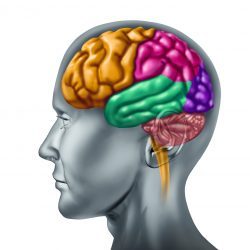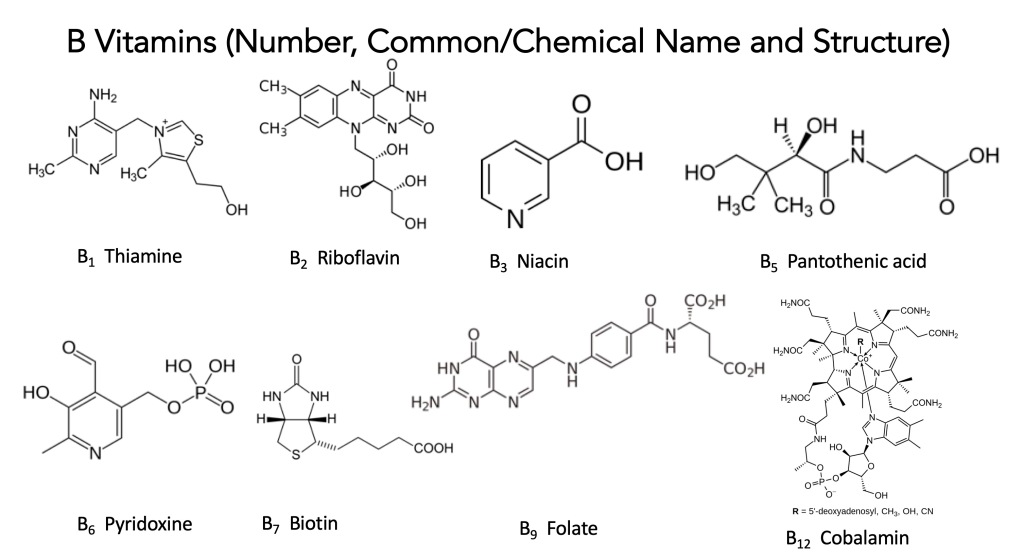“You can trace every sickness, every disease and every ailment to a mineral deficiency.” Linus Pauling
“We learn by our problems. We correct our deficiencies if there are any.” Joe Arpaio
Introduction: Several readers have written since the recent blog post on the B vitamins and their function linked to homocysteine levels “Revisiting the Role of B Vitamins to Reduce Homocysteine Levels Generated from Levodopa Therapy of Parkinson’s” (click here). The current post highlights the B vitamins, how we usually get them, and the signs and symptoms of a specific B vitamin deficiency or excess. This is a topic I frequently lectured on during my academic career and, in my opinion, important material. It highlights the importance of eating a balanced and nutritious diet. But first, a little background.
“Life is possible only by the deficiencies of our imagination and memory.” Emile M. Cioran
Naming the Vitamins: According to the textbooks, Dr. Casimir Funk used the term “Vitamines,” which was short for ‘vital amines.’ However, in 1912, they found that amines were not essential; therefore, they shortened the name to vitamins. For an excellent lesson in vitamin history, “How vitamins got their name,” (click here).
Dr. Funk discovered a substance that cured Beriberi; thus, the B was applied in the name of vitamin B. Following this discovery, the vitamins were given names following the alphabet as they were reported. Then they had numbers attached, but they were not consistent. Later, many scientists and physicians stating using common names based on their molecular structures. For instance, most say thiamine and folate, not vitamin B1 and vitamin B9, respectively. It is a total mess, and that is just the B vitamins (there are also vitamins of A, C, D, E, and K; do not ask what happened to vitamins F-J!). It is a mixed-up world.
“Learn to appreciate what you have and where and who you are.” Wayne Dyer
The B Vitamins: We consider the following eight substances as the B vitamins. They are known to be water-soluble. That is, they can be dissolved in water. The B vitamins’ names/numbers and structures are presented in the figure below.
“The man who does not know other languages, unless he is a man of genius, necessarily has deficiencies in his ideas.” Victor Hugo
Where are B Vitamins Found? B vitamins are abundant in meat (turkey, tuna, and liver), eggs, and dairy products. Processed and refined products like sugar and white flour tend to have lower B vitamins than their unprocessed counterparts. In the USA and many other countries, several B vitamins, including thiamine, riboflavin, niacin, and folate, are added back to white flour after processing. This is known as “enriched flour.”
Likewise, folate is found in green leafy vegetables and different meats, as shown in the figure below. Furthermore, the plant group of legumes that includes beans, peas, and peanuts contains B vitamins. For a complete guide to plant B vitamins, see Cantwell-Jones, A., Ball, J., Collar, D. et al. Global plant diversity as a reservoir of micronutrients for humanity. Nat. Plants 8, 225–232 (2022). https://doi.org/10.1038/s41477-022-01100-6. Over-cooking food is one way to eliminate some B vitamins, especially folate. If one does not consume any food source with folate, a deficiency will occur in about four months.
Vitamin B12, or cobalamin, is not found in green leafy vegetables and is focused in dairy, eggs, and meats, as given in the figure below. Vitamin B12 is synthesized by bacteria and fungi and is required as a vitamin by animals but not by higher plants. Plants do not accumulate vitamin B12 or contribute it to the diet.
Compared to other B vitamins, vitamin B12, is relatively heat stable and not easily destroyed by over-cooking. Body stores of vitamin B12 are sufficient to meet the body’s needs for at least 8-10 years following a complete cessation of dietary intake or intestinal absorption. Dietary deficiency of vitamin B12 is usually restricted to vegetarians who do not eat any animal or dairy products (that is, strict vegans).
Due to the critical role that vitamin B12 play in human physiology, we have evolved several processes to ensure the small amount of vitamin B12 we possess stays with us. The details of the metabolism and processing of vitamin B12 are highlighted in the schematic below. And yes, a defective mechanism or inborn genetic error results in a deficiency of vitamin B12. The best example is an autoimmune attack of stomach parietal cells, destroying the synthesis of intrinsic factor, which is responsible for transporting vitamin B12 through the gastrointestinal tract. The loss of intrinsic factor leads to pernicious anemia (pernicious means having a harmful effect gradually).

“Virtue is the golden mean between two vices, the one of excess and the other of deficiency.” Aristotle
Highlighting Vitamin B12 and Folate Deficiency: Generally, B vitamins are involved in many aspects of cell metabolism and red blood cell development. As already described, folate and vitamin B12 are essential in DNA metabolism and in treating Parkinson’s with carbidopa/levodopa. In general, folate and vitamin B12 work in concert regarding DNA metabolism. And vitamin B12 has a unique role in maintaining the myelin sheath around nerves. If you develop a deficiency in either folate or vitamin B12, the vitamins could be quantified in your blood. They would likely screen for homocysteine, and methylmalonic acid converted to methylmalonyl-coenzyme A (CoA). Based on the figure below, one could obtain much information comparing these compounds and their concentration in the person’s blood.

Regarding a folate deficiency, one would see an increase in homocysteine due to the absence of folate would alter DNA processing [please see the schematic (that I am very proud of) showing the roles of B vitamins in various aspects of our metabolism) in “Revisiting the Role of B Vitamins to Reduce Homocysteine Levels Generated from Levodopa Therapy of Parkinson’s” (click here)]. Regarding a vitamin B12 deficiency, one would find increases in homocysteine and methylmalonic acid since it has an additional role in myelin synthesis. A shortage of either B vitamin would lead to a special kind of anemia in red blood cells called macrocytic anemia.
·Clinical features of either vitamin B12 or folate deficiency include weakness and shortness of breath; GI symptoms (diarrhea), loss of appetite, nausea; exercise intolerance; the appearance of hypersegmented neutrophils in the blood, preceding the development of megaloblastic (larger than normal red blood cells) anemia. Due to its role in myelin synthesis, vitamin B12 deficiency could also develop neuro-psych manifestations (may be present in the absence of anemia), degeneration of the spinal cord (loss of position and vibration sense), optic nerve atrophy, and psychiatric symptoms (dementia, personality change, psychosis).
“Temperance and bravery, then, are ruined by excess and deficiency, but preserved by the mean.” Aristotle
Deficiencies of B Vitamins: Below are short summaries of having a deficiency in a given B vitamin.
•Vitamin B1, Thiamine: Thiamine deficiency causes beriberi. Symptoms of this nervous system disease include weight loss and emotional disturbances. Additionally, there would be weakness and pain in the limbs, the development of an irregular heartbeat, and edema (swelling of bodily tissues).
•Vitamin B2, Riboflavin: Riboflavin deficiency may lead to cheilosis (cracks in the lips), increased sensitivity to light, glossitis (tongue inflammation), seborrheic dermatitis (inflammatory skin), and pharyngitis.
•Vitamin B3, Niacin: Niacin deficiency and a shortage of tryptophan cause pellagra. Symptoms include aggression, dermatitis, insomnia, weakness, mental confusion, and diarrhea.
•Vitamin B5, Pantothenic acid: Pantothenic acid deficiency can result in acne and paresthesia (tingling position).
•Vitamin B7, Biotin: Biotin deficiency does not typically cause symptoms in adults, other than cosmetic issues such as decreased hair and nail growth. However, a biotin deficiency may lead to impaired infant growth and neurological disorders.
•Vitamin B9, Folate: Folate deficiency results in macrocytic anemia and elevated homocysteine levels. Lack of folate in pregnant women can lead to birth defects, particularly neural tube defects.
•Vitamin B12, Cobalamin: Vitamin B12 deficiency results in macrocytic anemia, elevated methylmalonic acid and homocysteine, peripheral neuropathy, sense loss, change in mobility, memory loss, and other cognitive deficits. It is most likely to occur among older adults, as absorption through the gastrointestinal tract declines with age.
“The habit of common and continuous speech is a symptom of mental deficiency. It proceeds from not knowing what is going on in other people’s minds.” Walter Bagehot
Can One Take Too Much of A Good Thing? Many take a fair excess over the minimum daily requirement (MDR) for several B vitamins. Here’s what we can determine about whether ingesting large amounts of B vitamins is safe.
•Thiamine, riboflavin, pantothenic acid, and biotin apparently have no ceiling for toxicity.
•There is no established maximum for vitamin B12.
•However, regarding niacin, there is a maximum suggested not to exceed 3000 mg for nicotinamide and 1500 mg/day for nicotinic acid. The most severe side-effect would be signs of liver toxicity, nausea, and vomiting. Although many take a fair amount of niacin to control advancing cardiovascular disease, there are well-established limits to consider when taking a derivative of niacin.
•The maximum for folate is 1 mg/day, and the person would begin to have nausea, diarrhea, irritability, confusion, behavior changes, and seizures. A concern with too much folate is that is might mask a deficiency in vitamin B12, and depending on the length of time, the neuropathy produced from the B12 scenario might not be reversible.
•Megavitamin-B6 syndrome is the name given to a chronic overdose of vitamin B6. This would be between 25-100 mg/day. Clinically, this would be a neuropathy, unsteady gait, and involuntary muscle movements.
“Only a man who cannot conquer his deficiencies feels the need to convince the world that he has none.” Margaret Weis
Conclusions: The B vitamins are participants in our daily lives. Their absence contributes to real illnesses. In our everyday lives with Parkinson’s, the B vitamins are crucial to our better health. Many people-with-Parkinson’s (PwP) take mega-doses of thiamine in a regimen called high-dose-thiamine (HDT). PwP take up to 4 grams of vitamin B1 daily.
Others take vitamin B12 as it contributes to overall brain health. One piece of advice I have learned from physicians is to take vitamin B12 as methyl-cobalamin, not the more common cyano-cobalamin. Cyano-cobalamin breakdown generates a small amount of cyanide, which could damage your kidneys over time. And if your kidney function is lower than usual, try to take methyl-cobalamin for your vitamin B12.
Finally, know the vitamin content in you. It makes sense to screen for the major B vitamins you take at least once per year when the PwP meets with their neurologist. Keeping track of this information provides a simple road marker down the superhighway we drive to manage our Parkinson’s.
“We judge people in areas where we’re vulnerable to shame, especially picking folks who are doing worse than we’re doing. If I feel good about my parenting, I have no interest in judging other people’s choices. If I feel good about my body, I don’t go around making fun of other people’s weight or appearance. We’re hard on each other because we’re using each other as a launching pad out of our own perceived deficiency.” Brené Brown
Cover Photo Image by Evgeni Tcherkasski from Pixabay






One Reply to “”